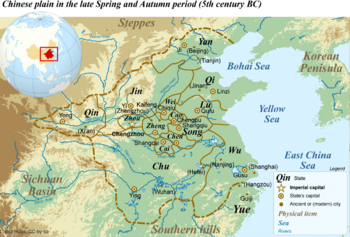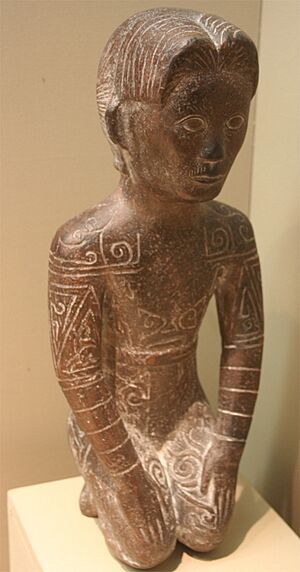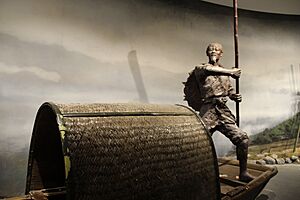Yue (state) facts for kids
Quick facts for kids
State of Yue
越
|
|||||||||
|---|---|---|---|---|---|---|---|---|---|
| ?–306 BC | |||||||||

Map of the Chinese plain in the 5th century BC. The state of Yue is located in the southeast corner.
|
|||||||||
| Status | Kingdom | ||||||||
| Capital | Kuaiji, later Wu | ||||||||
| Government | Monarchy | ||||||||
| King | |||||||||
|
• 496–465 BC
|
Goujian | ||||||||
| Historical era | Spring and Autumn period Warring States period |
||||||||
|
• Established
|
? | ||||||||
|
• Conquered by Chu
|
306 BC | ||||||||
|
|||||||||
| Yue | |||||||||||||||||||||||||||||||||||
|---|---|---|---|---|---|---|---|---|---|---|---|---|---|---|---|---|---|---|---|---|---|---|---|---|---|---|---|---|---|---|---|---|---|---|---|

"Yue" in seal script (top) and modern (bottom) Chinese characters
|
|||||||||||||||||||||||||||||||||||
| Chinese | 越 | ||||||||||||||||||||||||||||||||||
|
|||||||||||||||||||||||||||||||||||
Yue (Chinese: 越) was an ancient state in China. It existed over a thousand years ago, during the Spring and Autumn period and Warring States period. These were times when many different states fought for control in China.
Yue was located in what is now Zhejiang, Shanghai, and Jiangsu provinces. Its first capital city was Kuaiji, which is now Shaoxing. Later, after it conquered another state called Wu, Yue moved its capital north to the city of Wu, known today as Suzhou. The state of Yue was eventually taken over by the state of Chu in 306 BC.
Contents
History of Yue
The kingdom of Yue, also called "Yue Guo," became well-known in the late 6th century BC. This was when it started fighting a series of wars against its neighbor to the north, the state of Wu.
Ancient Chinese records say that the people of Yue were descendants of Wuyu. He was the son of Shao Kang, who was the sixth king of the Xia dynasty.
Yue got help from Chu, an enemy of Wu. After many years of fighting, Yue finally won. The famous Yue King Goujian defeated and took over Wu in 473 BC. Many years later, during the rule of King Wuqiang, Yue was divided up by the states of Chu and Qi in 306 BC.
The state of Yue was very famous for its amazing metalwork. They made especially good swords. Two examples are the well-preserved Swords of Goujian and Zhougou.
The Yue people lived in the lower Yangtze River area. They had unique traditions, like pulling out teeth, building homes on stilts, and burying their dead in cliffs. People who spoke Austronesian languages also lived in this region until about 240 BC.
What made Yue different from other Chinese states was its strong navy. The Yue culture also had a special way of naming their boats and swords. An old Chinese text said that the Yue people used boats like carriages and oars like horses!
Rulers of Yue
The rulers of Yue had an ancestral name that is sometimes written as Si or Luo.
| Rulers of Yue family tree | |||||||||||||||||||||||||||||||||||||||||||||||||||||||||||||||||||||||||||||||||||||||||||||||||||||||||||||||||||||||||||||||||||||||||||||||||||||||||||||||||||||
|---|---|---|---|---|---|---|---|---|---|---|---|---|---|---|---|---|---|---|---|---|---|---|---|---|---|---|---|---|---|---|---|---|---|---|---|---|---|---|---|---|---|---|---|---|---|---|---|---|---|---|---|---|---|---|---|---|---|---|---|---|---|---|---|---|---|---|---|---|---|---|---|---|---|---|---|---|---|---|---|---|---|---|---|---|---|---|---|---|---|---|---|---|---|---|---|---|---|---|---|---|---|---|---|---|---|---|---|---|---|---|---|---|---|---|---|---|---|---|---|---|---|---|---|---|---|---|---|---|---|---|---|---|---|---|---|---|---|---|---|---|---|---|---|---|---|---|---|---|---|---|---|---|---|---|---|---|---|---|---|---|---|---|---|---|---|
|
|||||||||||||||||||||||||||||||||||||||||||||||||||||||||||||||||||||||||||||||||||||||||||||||||||||||||||||||||||||||||||||||||||||||||||||||||||||||||||||||||||||
After the Fall of Yue
After the state of Yue fell, its ruling family moved south. They settled in what is now northern Fujian province. There, they created a new kingdom called Minyue. This kingdom lasted until about 150 BC. It ended after it made a bad alliance with the Han dynasty.
Mingdi, who was King Wuqiang's second son, became a minister in Wucheng. This area is now Huzhou's Wuxing District. He was given the title Marquis of Ouyang Ting. This title came from a pavilion on the south side of Ouyu Mountain. The first emperor of the Qin dynasty, Qin Shi Huang, removed this title in 223 BC. However, descendants of the former rulers took on surnames like Ou, Ouyang, and Ouhou to remember their past.
Much later, in 172 CE, a religious leader named Xu Chang started a rebellion. He announced that the state of Yue was restored and made his father, Xu Sheng, "King of Yue." But the rebellion was quickly stopped in 174 CE.
Yue in Astronomy
In ancient Chinese astronomy, two stars are named after Yue:
- The star Zeta Aquilae in the "Left Wall" of the Heavenly Market enclosure represents Yue (along with Wu).
- The star Psi Capricorni or 19 Capricorni in the "Twelve States" of the Girl constellation also represents Yue.
Famous People from Yue
- Yuenü: A skilled swordswoman who wrote one of the earliest known guides on sword fighting.
- Xi Shi: A very famous beauty from the ancient state of Yue.
Language of Yue
People in the state of Yue might have spoken languages from the Tai-Kadai or Austronesian families. Researchers have found many words in the Maqiao Wu dialect, spoken near Shanghai, that are similar to Tai-Kadai words. These words are thought to be traces of the "old Yue language."
See also
- Tai languages
- Tai-Kadai languages
- Austronesian languages
- Austro-Tai languages
- Tai peoples
- Austronesian peoples
- Austro-Tai peoples
- Baiyue
- Minyue
- Wu (state)
- Dong'ou Kingdom
- Âu Việt
- Lạc Việt




